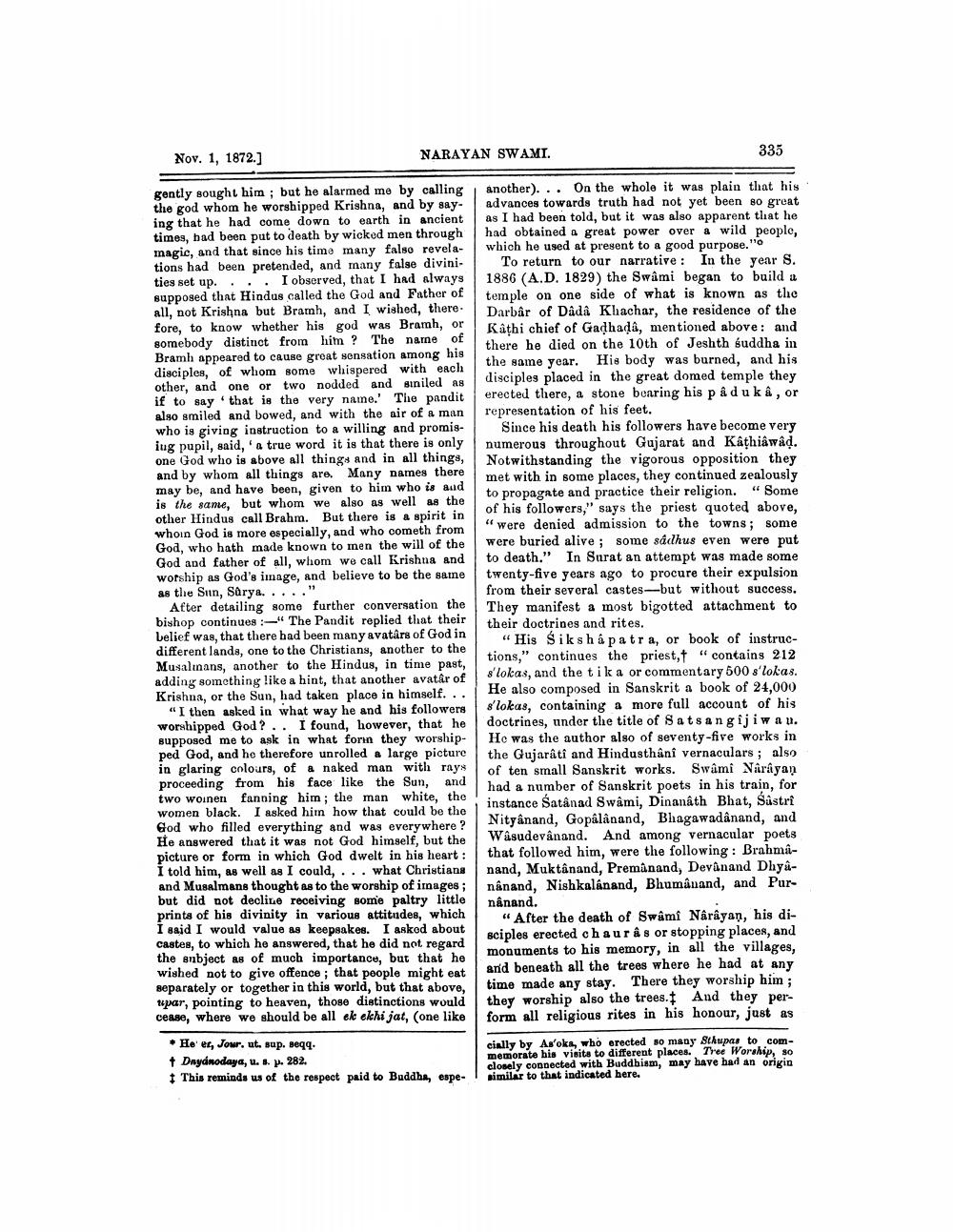________________
Nov. 1, 1872.]
NARAYAN SWAMI.
335
gently sought him ; but he alarmed me by calling the god whom he worshipped Krishna, and by say. ing that he had come down to earth in ancient times, had been put to death by wicked men through magic, and that since his time many falso revelations had been pretended, and many false divinities set up...I observed, that I had always supposed that Hindus called the God and Father of all, not Krishna but Bramh, and I wished, there. fore, to know whether his god was Bramh, or somebody distinct from him? The name of Bramh appeared to cause great sensation among his disciples, of whom some whispered with each other, and one or two nodded and siniled as if to say that is the very name. The pandit also smiled and bowed, and with the air of a man who is giving instruction to a willing and promis. iug pupil, said, 'n true word it is that there is only one God who is above all things and in all things, and by whom all things are. Many names there may be, and have been, given to him who is aud is the same, but whom we also as well as the other Hindus call Brahm. But there is a spirit in whoin God is more especially, and who cometh from God, who hath made known to men the will of the God and father of all, whom we call Krishna and worship as God's image, and believe to be the same as the Sun, Sarya....."
After detailing some further conversation the bishop continues "The Pandit replied that their belief was, that there had been many avatars of God in different lands, one to the Christians, another to the Musalınans, another to the Hindus, in time past, adding something like a hint, that another avatar of Krishna, or the Sun, had taken place in himself...
"I then asked in what way he and his followers worshipped God? .. I found, however, that he supposed me to ask in what for they worship- ped God, and he therefore unrolled a large picture in glaring colours, of a naked man with rays proceeding from his face like the Sun, and two woinen fanping him; the man white, the women black. I asked him how that could be the God who filled everything and was everywhere? He answered that it was not God himself, but the picture or form in which God dwelt in his heart: I told him, as well as I could,... what Christians and Musalmans thought as to the worship of images; but did not decline receiving some paltry little prints of his divinity in various attitudes, which I said I would value as keepsakes. I asked about castes, to which he answered, that he did not regard the enbject as of much importance, but that he wished not to give offence; that people might eat separately or together in this world, but that above, wspar, pointing to heaven, those distinctions would Ceas, where we should be all ek ekhi jat, (one like
another)... On the whole it was plain that his advances towards truth had not yet been so great as I had been told, but it was also apparent that he had obtained a great power over a wild people, which he used at present to a good purpose."
To return to our narrative : In the year S. 1886 (A.D. 1829) the Swami began to build a temple on one side of what is known as the Darbâr of Dada Khachar, the residence of the Kathi chief of Gadhada, mentioned above: and there he died on the 10th of Jeshth suddha in the same year. His body was burned, and his disciples placed in the great domed temple they erected there, a stone bearing his på duka, or representation of his feet.
Since his death his followers have become very numerous throughout Gujarat and Kathiâwâd. Notwithstanding the vigorous opposition they met with in some places, they continued zealously to propagate and practice their religion. “Some of his followers," says the priest quoted above, " were denied admission to the towns; some were buried alive ; some sádlhus even were put to death." In Surat an attempt was made some twenty-five years ago to procure their expulsion from their several castes-but without success. They manifest a most bigotted attachment to their doctrines and rites.
"His Sikshapatra, or book of instructions," continues the priest, "contains 212 s'lokas, and the tika or commentary 500 s lokas. He also composed in Sanskrit a book of 24,000 s'lokas, containing a more full account of his doctrines, under the title of Satsangijiwau. He was the author also of seventy-five works in the Gujarati and Hindusthani vernaculars; also of ten small Sanskrit works. Swami Narayan had a number of Sanskrit poets in his train, for instance Satânad Swami, Dinanath Bhat, Sústri Nityanand, Gopâlânand, Bhagawadânand, and Wasudevanand. And among vernacular poets that followed him, were the following: Brahmanand, Muktänand, Premanand, Devanand Dhyananand, Nishkalanand, Bhumanand, and Purnânand.
"After the death of Swami Narayan, his disciples erected chaurâs or stopping places, and monuments to his memory, in all the villages, and beneath all the trees where he had at any time made any stay. There they worship him; they worship also the trees. And they perform all religious rites in his honour, just as
• Heer, Jour. ut. sup. seqq.
Dnyanodaya, u. . p. 282. This reminds us of the respect paid to Buddha, espe-
cially by As'oks, who erected so many schupas to commemorate his visita to different places. Tree Worship, so closely connected with Buddhism, may have had an origin similar to that indicated here.




